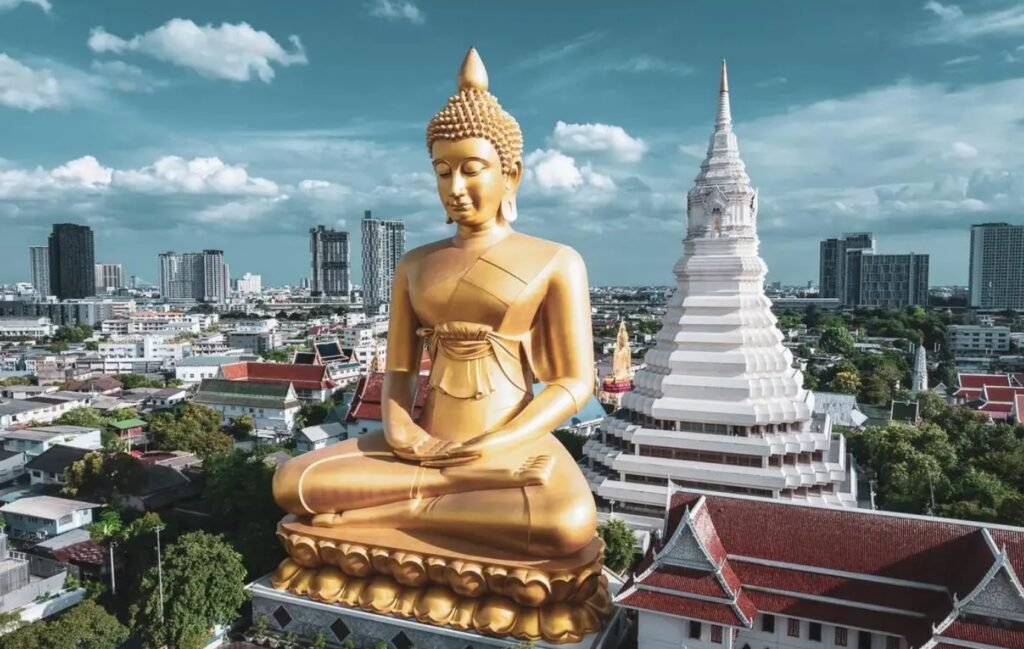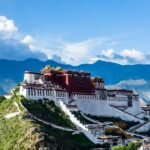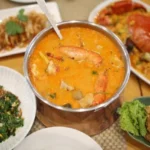Bangkok Overview:
“Hot, noisy, crowded, humid, but still lovable.” There are countless reasons to love Bangkok, and many people describe it in this way. One key reason is undoubtedly its “colors.” As Thailand’s capital, Bangkok is a city brimming with vibrancy in every corner:
- “Colors” – No other city is quite like Bangkok when it comes to traffic jams that last all day long. But the brightly colored taxis, the cartoonish tuk-tuks, and the lively street-side houses make being stuck in traffic almost enjoyable in this colorful city.
- “Flavors” – The love for spicy, sour, and seafood is deeply ingrained in Bangkok’s people. Add in the array of spices from this “land of spices,” and whether you’re sitting at a street-side stall or dining elegantly at a fine restaurant, the variety of food and enticing aromas will surely make your mouth water.
- “Looks” – In this city, home to many manufacturing centers, you’ll find a variety of colorful products at great prices. Can your inner shopper resist the temptation?
- “Temptation” – Beautiful women have always been admired throughout history, and in Bangkok, you’ll find plenty of stunning “women.” With their fair skin, bold eyebrows, and striking figures, they’ll awaken your primal desires with their unique presence.
Siam Square: The ultimate shopping destination
Chinatown: A hub of Chinese and international delicacies
Khao San Road: A backpacker’s paradise
Personal Impressions:
Do you remember Siam Square? Youthful, fresh-faced Thai teens roam here in groups, laughing and calling out to friends in the distance. Many years ago, my impression of Bangkok was framed by the vibrant energy of Siam Square, and today, it remains exactly as I remembered it.
One of my favorite things to do in Bangkok is to wander through the alleys, hop on a Skytrain or jump on a ferry, pretending I’m not a tourist but a local, blending into the pure, everyday life here. Bangkok is such a beautiful city that it’s no surprise when people say it’s a place you’d want to stay forever.
Best Time to Travel:
Bangkok has a tropical monsoon climate, and it stays hot all year round. The best time to visit is between November and January, with average temperatures around 25°C (77°F), which are very pleasant. December, in particular, is considered the best month of the year to visit. From June to October, Bangkok experiences its rainy season, with frequent, though brief, rain showers. However, the wet environment might affect your travel experience. It’s recommended to avoid visiting in April and May, as these are the hottest months of the year, with average temperatures soaring up to 38°C (100°F).
Clothing Tips:
With an average yearly temperature of 27.5°C (81.5°F), lightweight and comfortable summer clothes are suitable no matter when you visit Bangkok. Since the air conditioning in the subway and indoor spaces can be quite cold, those who are sensitive to cool air should bring a light jacket. During the rainy season, don’t forget to pack rain gear for those unexpected downpours.
Bangkok Tourist Spots
Bangkok doesn’t have an overwhelming number of tourist attractions, so 2-3 days are enough to see the main sites. For young people who enjoy excitement and nightlife, Khao San Road is a must-visit. Photography lovers and temple enthusiasts shouldn’t miss the Rattanakosin Island area, home to The Grand Palace. Shopping addicts will find plenty to explore in mall districts like Siam Square, while budget-conscious backpackers looking to experience the local markets should head to the Chatuchak Weekend Market. And for the artsy crowd, don’t forget to bring your camera to capture the unique market scenes around the Chao Phraya River, one of Southeast Asia’s most iconic riverfront markets.
The Grand Palace and Wat Phra Kaeo (Temple of the Emerald Buddha)
The Grand Palace is a symbol of Bangkok and the most well-preserved, largest, and most culturally significant royal palace in Thailand’s history. Stretching from east to west, the palace features stunning green ceramic-tiled ridges and roofs made of purple-red glazed tiles, creating an imposing and grand structure. The intricate paintings, sculptures, and decorative arts will leave you in awe. Among its buildings, the Chakri Maha Prasad and Dusit Maha Prasad are the most famous, with some calling this place the “Encyclopedia of Thai Art.”
Within the Grand Palace complex is the Wat Phra Kaeo (Temple of the Emerald Buddha), the most sacred temple in Thailand. This temple is where the royal family worships the Emerald Buddha, and where the king holds coronation ceremonies and Buddhist rituals. It’s also the only temple in Thailand where no monks reside. The Emerald Buddha, along with the Reclining Buddha and the Golden Buddha, is considered one of Thailand’s three national treasures.


Tips: When visiting, make sure your clothing is not too revealing. Items like shorts, mini skirts, short skirts, see-through clothing, sleeveless tops, crop tops, ripped jeans, and flip-flops are not allowed. If your attire doesn’t meet the requirements, there are free clothes available to borrow at the entrance, but be prepared for a long wait. It’s better to plan ahead and dress appropriately before leaving.
The Grand Palace has only one entrance, and it’s not very obvious. There are a few other gates nearby that may be open, but they are not for visitors. If someone approaches you and says, “The Grand Palace is closed today for worship and is not open to tourists, come back another day,” don’t believe them. This is a scam, and they will try to take you to other places and charge you extra.
After exiting the Grand Palace, you may encounter vendors trying to sell you things. If you’re interested in buying, remember to negotiate the price.
Wat Pho (Temple of the Reclining Buddha)
Wat Pho is the oldest and largest temple in Bangkok, and it houses one of the largest reclining Buddha statues in the world. The temple complex is divided into several sections, including the ordination hall, monk quarters, and numerous stupas, making it the temple with the largest number of Buddha statues and stupas in Bangkok, earning it the nickname “The Temple of a Thousand Buddhas.” The reclining Buddha rests with his right hand supporting his head, exuding a serene and contemplative expression that brings a sense of peace and calm to visitors.
Wat Pho is also the site of Thailand’s first public university and serves as a center for traditional Thai massage education and certification. Don’t miss the chance to experience a professional Thai Massage while visiting the temple.
Tips: One unique feature of Wat Pho is that you can exchange 60 baht for a bowl of coins. You then drop one coin into each bowl as you walk around the hall, which is believed to bring good luck or grant wishes. As you walk through the temple, you’ll hear the distinctive sound of coins dropping into the bowls, creating a serene and special “ding-dong” sound throughout the hall.

Wat Arun (Temple of Dawn)
Wat Arun, also known as the Temple of Dawn, is one of Thailand’s royal temples. It is the second largest, after the Grand Palace and Wat Phra Kaeo. The main tower of the temple houses a statue and relics of King Taksin, and traditional Chinese lanterns hang inside the hall. The temple’s biggest annual celebration is the Royal Thod Kathin Ceremony, held every December, which is one of the most important royal ceremonies in Thailand.
The central tower of the temple, known as the Phra Prang, stands 79 meters tall and is designed in the Brahmin style. Often referred to as “Thailand’s Eiffel Tower,” it is one of the best spots to get a panoramic view of the Chao Phraya River and enjoy the night scenery.

Tips:
Inside the temple, there is a tall tower with steep stairs, so be cautious while climbing. The view from the top is fantastic, and on the highest level, there is a yellow cloth where you can write your wishes, so remember to bring a permanent marker. At night, the temple is beautifully illuminated, and seeing it from a boat on the Chao Phraya River is truly breathtaking.
Erawan Shrine (Four-Faced Buddha)
Located in the Erawan Shrine, the statue of the Four-Faced Buddha has four faces, each representing the four virtues: loving-kindness, compassion, sympathetic joy, and equanimity. It is famous for its spiritual power and granting wishes. November 9th is the Buddha’s birthday, and during this time, many international celebrities and stars gather here to offer incense and prayers. It is said that Deborah, the mother of Nicholas Tse, once performed a naked dance in front of the statue to fulfill a vow.
The shrine is located in the bustling city center, surrounded by shopping malls. People dressed in trendy outfits can be seen offering devout prayers. You can bring flower garlands and candles to make offerings and pray—who knows, your wishes might just come true!

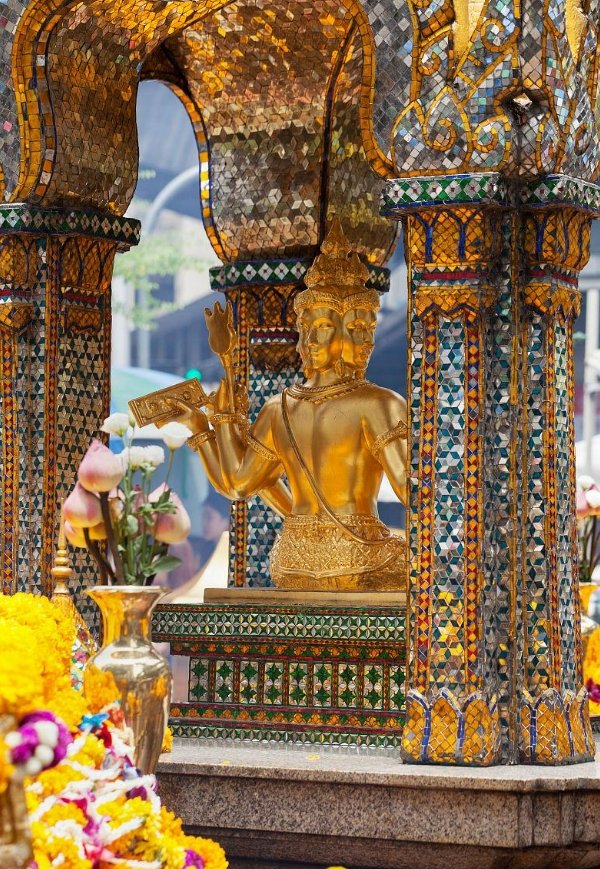
Many Asians come here to pray and seek blessings, while Westerners tend to come for photos and to see what the excitement is about. In any case, the place is always packed with people. We bought incense, candles, and flower garlands, and after much effort, found a small space to make our wishes. Honestly, we’re more than willing to return to fulfill our vows if our wishes come true.
Wat Traimit (Temple of the Golden Buddha)
Also known as the Golden Buddha Temple, Wat Traimit is famous for housing a statue of the Buddha made entirely of pure gold. You will be awestruck by the brilliance and solemnity of this golden Buddha. The temple itself is not very large, but it is often packed with dozens of tour buses, making it quite crowded. After disembarking, most visitors head straight to the Buddha hall on the second floor. Inside this small hall, which is less than 100 square meters, sits a Buddha statue made of 70% pure gold. The statue stands 3 meters tall and weighs over 5 tons.


Chinatown
Chinatown is one of the busiest commercial districts in the city, made up of Sampeng Lane, Yaowarat Road, Charoen Krung Road, and many connecting streets and alleys. It preserves traditional Chinese culture and customs of the Chinese community, attracting many visitors from China and other countries. Here, you can enjoy various Teochew-style dishes and Cantonese snacks.
Many locals in this area speak Mandarin, Cantonese, or Teochew dialect. The streets are lined with gold shops and seafood restaurants, with many small shops specializing in bird’s nest and shark fin soup. Be cautious, though, as it’s said that some stores sell fake bird’s nests, so if you plan to buy, bring someone knowledgeable with you. The roads are narrow and crowded with cars, making it a lively area. The small alleys are full of street vendors, and there are many fruit sellers on the roadside, especially selling durians that are both cheap and delicious—definitely worth buying more.
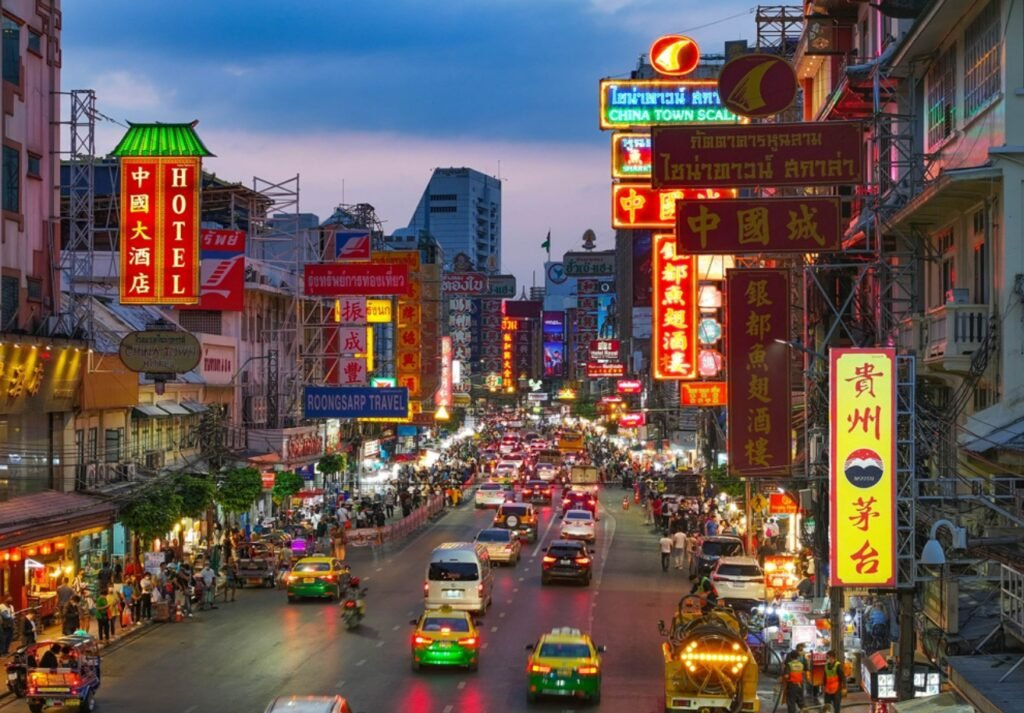



National Museum
The Thailand National Museum, established in 1782, is the largest museum in Southeast Asia. It houses a vast collection of sculptures and cultural artifacts from various periods of Thai history. The museum’s history section offers a detailed account of Thailand’s past, from the Neolithic era to modern times. Visiting here allows you to embark on a journey through Thai history and culture, enriching your understanding of Thai traditions and enhancing your overall experience of Bangkok.
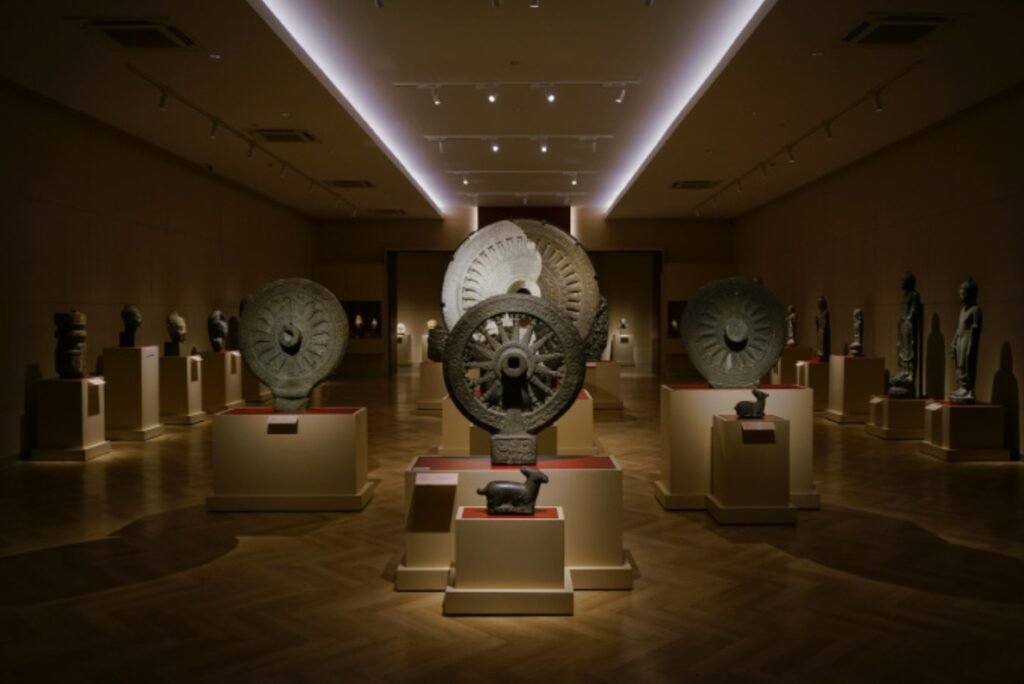
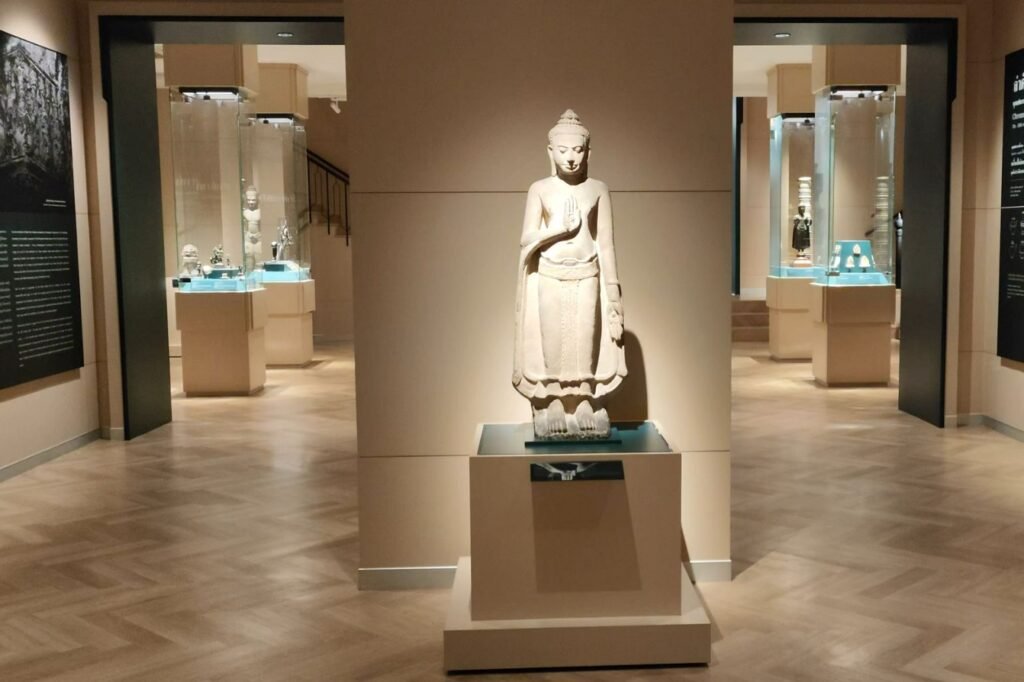
Bangkok Art and Culture Centre
This modern art gallery, located in the heart of the city, highlights the government’s commitment to promoting art and culture. The center showcases the latest contemporary art and attracts many visitors, fostering cultural exchange. Here, you can experience Bangkok’s fashionable and youthful energy, gaining a deeper understanding of this vibrant city. The gallery features many creative works and innovative ideas, making it a place where you can truly spend time leisurely exploring. There are floors where you can freely graffiti, walls where you can post anything, and spaces to cut out and collage images from various magazines—it’s full of inventive and imaginative activities. I love this place.


Accommodation Guide
You never need to worry about finding a place to stay in Bangkok. One reason Bangkok is consistently ranked among the best tourist cities in the world is its wide range of accommodations—from luxurious five-star hotels to budget-friendly hostels with bunk beds. No matter where you stay, you can expect excellent service. Choosing a hotel near the BTS Skytrain or MRT stations is a great option for convenience. Most hotels and hostels can be booked online, though prices tend to increase during peak seasons, so it’s best to check the current rates.
If you’re a foodie, I recommend staying near Chulalongkorn University. The food streets around the university are sure to delight your taste buds!
Food Guide
Bangkok is a foodie’s paradise, with delicious options on every street corner. Wherever you go, you’ll find something to eat—whether it’s fresh fruit from street vendors or famous Thai dishes like Tom Yum Goong (spicy shrimp soup), Som Tam (green papaya salad), Mango Sticky Rice, and Pineapple Fried Rice. No matter your preference, you’re sure to find something that satisfies your cravings. Thai cuisine is known for its bold and spicy flavors, with common ingredients like chili, garlic, onion, and ginger. When eating Thai food, be adventurous and try the various dipping sauces.
Bangkok’s food scene is widespread. Near Siam Square, many shopping malls have food courts offering a wide variety of dishes in a comfortable setting—perfect for a break after a day of shopping. Chinatown offers not only Chinese cuisine but also a variety of street food. In the Sukhumvit area, you’ll find the famous Cabbages & Condoms restaurant, along with plenty of Korean and Japanese food options. There’s no shortage of local Thai specialties—you won’t leave hungry, but the challenge is trying everything!

Anyone tasting Thai Tom Yum Goong (spicy shrimp soup) for the first time will find its seasoning unique and its flavor refreshing. Those who love it will find that the more they eat it, the more flavorful and addictive it becomes.
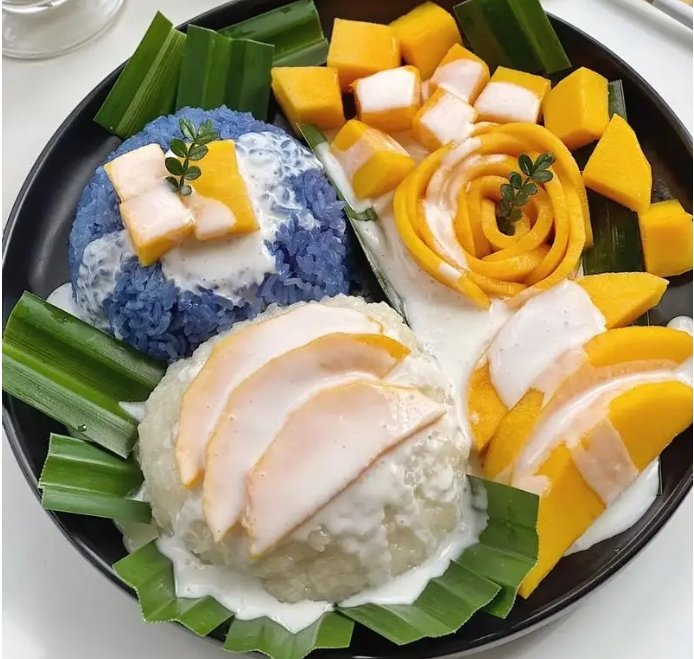
The sweet yet slightly tangy flavor of the mango perfectly blends with the sweetness of the Thai fragrant sticky rice soaked in rich coconut milk. It’s simply divine. The sticky rice is pure white like jade, while the mango shines like gold. After indulging in rich and heavy dishes, this refreshing and light dessert is the perfect palate cleanser.
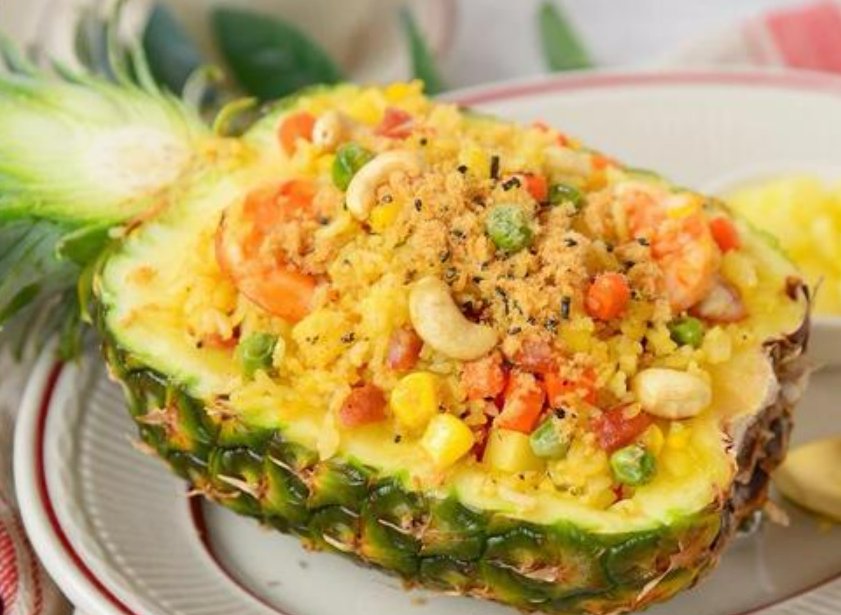
Fragrant Thai jasmine rice is stir-fried with pineapple and mixed vegetables over high heat, creating a flavor that’s both sweet, tangy, and slightly savory. Just one bite is enough to whet your appetite!

In Thailand, you can find Green Papaya Salad almost anywhere, whether from a street vendor or in most restaurants. It has a bold, strong flavor, and locals often enjoy it with sticky rice. Visitors from around the world quickly fall in love with this dish.

This dish is made with Thai jasmine rice, fresh basil leaves, and chicken thigh, with sugar, oyster sauce, and vegetable oil as key ingredients. It’s one of the most common meals for Thai office workers, but for foreign tourists, it’s considered a delightful treat.
Markets and Night Markets
Khao San Road Night Market
Khao San Road is a gathering place for backpackers in Bangkok. The alleyways are filled with unique little shops, with eye-catching signs that are easy to spot. At night, various stalls sell cheap T-shirts, souvenirs, and more, while the nightlife here is vibrant. Getting there: If you’re staying near Khao San Road, it’s easily accessible on foot, but if you’re in other areas, there’s no need to make a special trip just for it.
Chatuchak Weekend Market
The world’s largest flea market, with 15,000 stalls offering virtually anything you can imagine. The wide variety of goods attracts many foreign tourists. You can haggle freely here, but don’t lose track of time—the market closes at 6 PM. Since it’s huge, no matter which entrance you use, it’s recommended to grab a map to avoid getting lost. Start bargaining at 30% of the asking price and aim for 50% as a good deal. At the entrance, pick up a map and relax in the air-conditioned service area to plan your shopping trip, saving yourself some energy. If you plan to buy a lot, there are services within the market that can deliver your purchases to your hotel!
Asiatique The Riverfront Night Market
Located on Charoen Krung Road, Asiatique opened on April 27, 2012. As the largest night market in Asia, it has Thailand’s longest riverside boardwalk, used as a pier. Visitors can take a free boat from Saphan Taksin to the market, with boats running every half hour starting at 5 PM. Unlike typical night markets, Asiatique has a nostalgic, vintage vibe, with shops housed in old warehouses. Walking through it feels like being in a European town with a chic atmosphere. The night market also has a Ferris wheel, and as it rises, you can enjoy a stunning view of the Chao Phraya River at night. The area was originally the most important port during the reign of King Rama V, and it has been transformed into a modern night market offering dining, shopping, and entertainment. Asiatique is quite large, with high-end bars and restaurants near the riverside—perfect for grabbing a drink and relaxing. Inside, there are numerous shops offering a wide range of goods at different price points.
Patpong Night Market
Located next to Bangkok’s famous red-light district, Patpong Bar Street, the Patpong Night Market offers a mix of local street life and the red-light district’s unique atmosphere. Every evening, the street vendors begin setting up, staying open late into the night. Most stalls sell counterfeit T-shirts, bags, handicrafts, and souvenirs.
King Power Duty Free
King Power Duty Free belongs to the King Power International Group, featuring a variety of popular global fashion brands. The shopping space is elegant and comfortable, with several branches including King Power Downtown Bangkok, Suvarnabhumi International Airport, Sriwannee Branch, Don Mueang International Airport, Pattaya, Phuket International Airport, Hat Yai Airport, and Chiang Mai International Airport.
Entertainment Guide
Which city has the most exciting nightlife in the world? According to tourists, Bangkok ranks as the top of the 25 best nightlife cities globally. This vibrant city offers a variety of entertainment options, including massages and spas, dazzling ladyboy shows, thrilling Muay Thai (Thai boxing) performances, lively bars and nightclubs, and charming night cruises where you can sip on drinks while enjoying the atmosphere. There’s something for everyone to enjoy!
Thai Massage
Massage is a therapeutic practice based on traditional Chinese and Western medicine theories, involving pressing, kneading, and manipulating the body. In Hong Kong, Macau, and Taiwan, it’s colloquially known as “Ma Sa Ji”. In Thailand, massage shops are everywhere, offering authentic techniques at affordable prices. The skilled hands of the massage therapists leave you feeling completely refreshed and relaxed.
Ladyboy Shows
Watching a ladyboy show is a must when visiting Thailand. While the Tiffany Show in Pattaya is famous, Bangkok also has fantastic venues. The Calypso Cabaret is the most popular ladyboy show in Bangkok, where you can enjoy dazzling performances by ladyboys.
Lumphini Boxing Stadium
Address: No. 6 Ramintra Road, Anudsawaree, Bang Khen, Bangkok
Tuesday matches are the most exciting. One ticket grants you access to 8-10 matches, with the most thrilling ones happening toward the end. There’s no air conditioning inside, so get ready to feel the heat!
Bars and Nightclubs
There are three main areas popular among young people for nightlife:
- Khao San Road, where backpackers gather
- RCA District on Rama 9 Road, where trendy locals hang out
- Soi 11, Thonglor, and Ekkamai on Sukhumvit Road, which are upscale areas frequented by celebrities and white-collar workers.
Bangkok’s red-light districts are concentrated in three main areas:
- Patpong on Silom Road, known for its adult shows and gay bars
- Nana Plaza on Sukhumvit Road, which offers mid-to-high-end erotic bars and ladyboy bars
- Soi Cowboy, where the erotic bar scene has recently overshadowed Patpong.
Chao Phraya River Night Cruise
Known in Thailand as the Chao Phraya River, this river flows through Bangkok, dividing the city into two parts and earning Bangkok the nickname “Venice of the East.” During the day, it’s bustling with floating markets and transport boats, but at night, the riverside lights up, offering a more tranquil experience. You can take a traditional Thai boat ride to soak in the peace. There are many boats available from the Central Pier, and tickets can be purchased on the first floor of River City, near the Sheraton Hotel. Prices vary depending on the time slot, and there are photographers on hand to capture your experience. Tickets typically cost around 250 baht per person. While aboard, you can enjoy dinner and take in the scenic views, and there are plenty of entertainment options like karaoke, dancing, and drinks—making it a truly relaxing experience.
Bangkok In-Depth 5-Day Tour
Most tourists use Bangkok as a stopover while exploring Chiang Mai in the north or tropical islands in the south, typically staying for only 2-3 days. You can refer to the D1 + D2 + D5 itinerary for such a visit. However, Bangkok’s charm extends beyond its grand palaces and captivating city life. The nearby historical site of Ayutthaya and the local markets are also worth exploring. If you have more time, consider adding D3 or D4 to your itinerary based on your interests.
Itinerary Details:
D1:
- After breakfast, visit the National Museum, a great place to learn about Thailand’s history and culture.
- Then, walk to the Grand Palace, the most well-preserved and largest palace of the Bangkok dynasty, home to the national treasure, the Emerald Buddha.
- Next, visit the adjacent Wat Pho (Temple of the Reclining Buddha), the oldest and largest temple in Bangkok.
- For lunch, head to Poj Spa Kar, a royal cuisine restaurant near Khao San Road, where dishes are prepared with traditional royal culinary techniques.
- In the afternoon, take a ferry from the Tha Tien Pier outside the Grand Palace to Wat Arun (Temple of Dawn), known as the “Eiffel Tower of Thailand.”
- Afterward, take a bus to Tha Saphan Phut Pier and explore Chinatown, where you can shop and sample affordable shark fin soup and bird’s nest dishes.
- Walk along Yaowarat Road to visit Wat Traimit (Temple of the Golden Buddha), home to the world’s largest solid gold Buddha statue.
- By 7:00 PM, make your way to River City Pier to board a dinner cruise, complete with a buffet, live performances, and stunning views of the Chao Phraya River at night.
D2:
- If it’s the weekend, head to the Chatuchak Weekend Market, the world’s largest flea market, where you can find clothes, crafts, antiques, plants, pets, food, and more.
- For lunch, visit the food court at Or Tor Kor Market, just south of Chatuchak, for delicious and affordable Thai cuisine.
- In the afternoon, explore Dusit Palace Park, which is included in your Grand Palace ticket (valid for 7 days). This European-style royal palace complex includes the Chulalongkorn Monument, the Ananta Samakhom Throne Hall, and the Vimanmek Mansion, the largest golden teakwood mansion in the world.
- Then, visit the Erawan Shrine (Four-Faced Buddha), known for granting wishes and attracting many celebrities from Hong Kong and Taiwan.
- For dinner, head to Nara Restaurant, which has been named the best Thai restaurant for four consecutive years by several media outlets.
- End your day by experiencing Bangkok’s famous nightlife at Nana Plaza, a red-light district filled with adult bars, exotic dancers, and ladyboys.
D3:
- During the day, join a one-day tour to Ayutthaya Historical Park. Many tour agencies and hotels offer this package, which includes hotel pickup and transportation.
- In the evening, dine at the Sirocco Sky Bar at the Lebua Hotel, the world’s highest open-air restaurant. Enjoy stunning views of Bangkok’s skyline and neon lights under the stars.
- After dinner, walk to the BTS Saphan Taksin Station pier and take a free shuttle boat to Asiatique The Riverfront Night Market. Shop for crafts, enjoy traditional Thai performances, grab a drink at a bar, or ride the Ferris wheel for a view of Bangkok’s nightscape.
D4:
- Book a Railway Market and Floating Market day trip through a local travel agency, or take a minibus from Victory Monument on your own.
- The Maeklong Railway Market is known as “the world’s most dangerous market,” with stalls set up along the railway tracks. When the train approaches, vendors quickly pack up and reset once it passes—a unique sight found only here.
- After the market, catch a songthaew (pickup truck taxi) from the 7-Eleven near the railway tracks to Amphawa Floating Market, a less commercialized market popular with locals. When night falls, the market is illuminated by fireflies, making it even more beautiful.
- After visiting the floating market, take a minibus from Bangkok Bank back to Bangkok. From there, you can take a bus or plane to the ancient city of Sukhothai, a UNESCO World Heritage Site.
D5:
- In the morning, return to Bangkok from Pattaya by bus and prepare to leave Thailand. Before heading home, indulge in some shopping for souvenirs and gifts for family and friends.
- Bangkok is known as a shopping paradise, and the Siam district is the most convenient and comprehensive area for shopping. With a variety of malls and trendy shops, it’s a must-visit for any shopping enthusiast.

